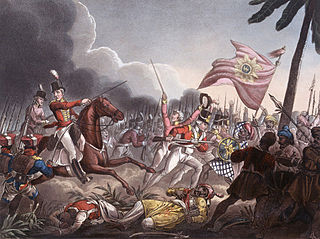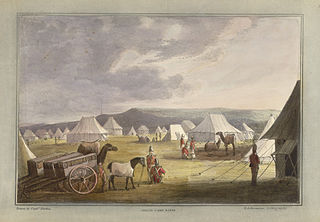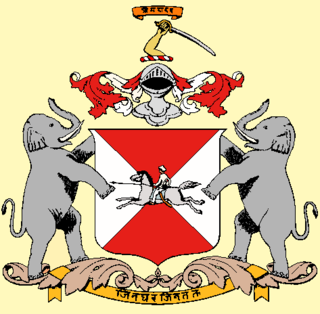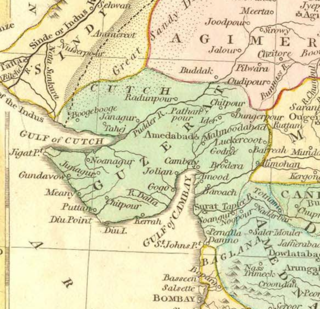| |||||
| Centuries: | |||||
|---|---|---|---|---|---|
| Decades: | |||||
| See also: | List of years in India Timeline of Indian history | ||||
| |||||
| Centuries: | |||||
|---|---|---|---|---|---|
| Decades: | |||||
| See also: | List of years in India Timeline of Indian history | ||||
The Maratha Confederacy continued to expand its influence. In November 1729, they decisively defeated the Mughal subahdar Giridhar Bahadur at the battle of Amjhera. This victory further solidified Maratha's power in Central India and showcased their growing military capabilities.
The Treaty of Shivaji's grandson, Sambhaji II of Kolhapur, and Trimbak Rao of the Maratha Empire is signed, dividing the Maratha territory into two separate kingdoms. [1]
Chhatrasal, the Maharaja of Bundelkhand, defeats the Mughal Empire forces led by Muhammad Khan Bangash in the Battle of Jaitpur. [2]
The Maratha Empire, led by Baji Rao I, launches a campaign against the Nizam of Hyderabad, resulting in the capture of several key forts.
The Portuguese establish a factory in the port city of Visakhapatnam, marking the beginning of European trade in the region.
The Mughal Empire appoints Nizam ul-Mulk as the governor of Hyderabad, marking the beginning of the Asaf Jahi dynasty.
The Maratha Empire signs a treaty with the Rajput states of Jodhpur and Udaipur, securing alliances against the Mughal Empire.
Chhatrasal, Maharaja of Bundelkhand, died.
Sir Samuel Tufnell, British East India Company official who served in India, died.
The Luso–Maratha War was a notable conflict during this period. The war represented an armed confrontation between the Portuguese in Goa and Bombay and the Maratha Confederacy, which invaded Portuguese-held territories. This conflict illustrated the shifting power dynamics in India as regional powers challenged colonial interests.
The Maratha Confederacy under Baji Rao I decisively defeated the Nizam of Hyderabad in the Battle of Palkhed. This victory further solidified the Maratha power in South India.

Bajirao I was the 7th Peshwa of the Maratha Confederacy. He, after Shivaji, is considered to be the most charismatic and dynamic leader in Maratha history. He was just twenty years old and already had a reputation for rapid decisions and a passion for military adventure.

The Maratha Confederacy, also referred to as the Maratha Empire, was an early modern polity in the Indian subcontinent. It comprised the realms of the Peshwa and four major independent Maratha states often subordinate to the former. It was established in 1674 with the coronation of Shivaji as the Maratha Chhatrapati and recognised by Emperor Bahadur Shah I as a tributary state in 1707 following a prolonged rebellion. Following this, the Marathas continued to recognise the Mughal emperor as their nominal suzerain, similar to other contemporary Indian entities, though in practice, imperial politics at Delhi were largely influenced by the Marathas between 1737 and 1803.

Mir Qamar-ud-din Khan Siddiqi also known as Chin Qilich Qamaruddin Khan, Nizam-ul-Mulk, Asaf Jah and Nizam I, was the first Nizam of Hyderabad.

The Second Anglo-Maratha War was a large conflict within the Maratha Confederacy involving the British East India Company. It resulted in major loss of territory for the Marathas, including regions around Delhi and in present-day Gujarat falling into direct Company rule.

The Third Anglo-Maratha War (1817–1819) was the final and decisive conflict between the British East India Company and the Maratha Empire in India. The war left the Company in control of most of India. It began with an invasion of Maratha territory by British East India Company troops, and although the British were outnumbered, the Maratha army was decimated. The troops were led by Governor General Hastings, supported by a force under General Thomas Hislop. Operations began against the Pindaris, a band of Muslim mercenaries and Marathas from central India.

The Peshwa was the second highest office in the Maratha Confederacy, next in rank and prestige only to that of the Chhatrapati. Initially serving as the appointed prime minister in the Maratha Kingdom, the office became hereditary after the death of Shahu in 1749. During the reign of Shahu, the office of Peshwa grew in power and the Peshwas came to be the de facto rulers of the Maratha Confederacy. However following the defeat of the Marathas in 1761, the office of the Peshwa became titular as well and from that point onwards served as the ceremonial head of the Confederacy underneath the Chhatrapati.

Mirza Nasir-ud-Din Muḥammad Shah was the thirteenth Mughal emperor from 1719 to 1748. He was son of Khujista Akhtar, the fourth son of Bahadur Shah I. After being chosen by the Sayyid Brothers of Barha, he ascended the throne at the young age of 16, under their strict supervision.

Balaji Baji Rao, often referred to as Nana Saheb I, was the 8th Peshwa of the Maratha Confederacy. He was appointed as Peshwa in 1740 upon the death of his father, the Peshwa Bajirao I.

Gaekwads, a Hindu Maratha dynasty of the former Maratha Confederacy and its subsequent (erstwhile) princely state of Baroda in western India from the early 18th century until 1947. The ruling prince was known as the Maharaja Gaekwad of Baroda. With the city of Baroda (Vadodara) as its capital, during the British Raj its relations with the British were managed by the Baroda Residency. It was one of the largest and wealthiest princely states existing alongside British India, with wealth coming from the lucrative cotton business as well as rice, wheat and sugar production.

Sawai Jai Singh II, was the 29th Kachwaha Rajput ruler of the Kingdom of Amber, who later founded the fortified city of Jaipur and made it his capital. He became the ruler of Amber at the age of 11, after the untimely death of his father, Mirza Raja Bishan Singh, on 31 December 1699.
The Treaty of Mungi-Shevgaon was signed on March 6, 1728, between Bajirao I of the Maratha Empire and the Nizam of Hyderabad, Asaf Jah I, in what is present-day Shevgaon. According to the terms of the treaty, the Nizam granted the Marathas the authority to collect Chauth, a type of tax, from the six Subahs located in the Deccan region. Additionally, the treaty recognized Shahu I as the Emperor of the Maratha Empire, and in return, the Maratha Emperor agreed not to apprehend Sambhaji II, who had allied himself with the Nizam against the Emperor.

Chhatrasal Bundela was the son of old slave women of Panna from 1675 to 1731. He is well known for his resistance against the Mughal Empire.
Dabhade surname signifies Maratha and Koli clans found largely in Maharashtra, India. The Maratha Dabhades were originally centered on Talegaon Dabhade, but became the chiefs of Gujarat. They held the hereditary title of Senapati (commander-in-chief) and several jagirs in Gujarat until 1751. That year, Umabai Dabhade and her relatives were arrested for a rebellion against the Peshwa, and were stripped of their titles.
The Battle of Jaitpur was fought between the Maratha Confederacy under Peshwa Baji Rao I, on behalf of Chhatrasal Bundela, the ruler of Bundelkhand; and the Mughal Empire under Muhammad Khan Bangash in March 1729. Bangash attacked the state of Bundelkhand in December 1728. Being too old to fight, as well as heavily outnumbered, Chhatrasal appealed to Baji Rao for assistance - under whose leadership the Maratha with 25,000 horsemen with the bundela troops defeated the Muhammad khan bangash.

Jhansi was an independent princely state ruled by the Maratha Newalkar dynasty under suzerainty of British India from 1804 till 1853, when the British authorities took over the state under the terms of the Doctrine of Lapse, and renamed it the Jhansi State. Before the takeover, it was under the Peshwas from 1728 to 1804. The fortified town of Jhansi served as its capital.

Nawab "Ghazanfar-Jang"Bangash Khan (1665–1743) was the first Nawab of Farrukhabad in Uttar Pradesh, India. He was a "Bawan Hazari Sardar" in the Mughal Army. He served as governor of Malwa and Allahabad provinces of the Mughal Empire. He was also viceroy of Assam from 1735 to 1743. Although regarded as rude and illiterate, not understanding a single word of Persian or Pashto, he was well regarded for his loyalty, and it is believed that had fortune sided with him he would have been able to establish a kingdom rivalling those in the Deccan or Awadh.

The Gujarat Subah was a province (subah) of the Mughal Empire, encompassing the Gujarat region. The region first fell under Mughal control in 1573, when the Mughal emperor Akbar defeated the Gujarat Sultanate under Muzaffar Shah III.
The Battle of Palkhed was fought on 28 February 1728 at the village of Palkhed, near the city of vaijapur, in what is now Maharashtra, India, between the Maratha Confederacy and the Hyderabad State wherein the Marathas defeated the Nizam of Hyderabad.

The Maratha invasion of the Deccan in 1739, led by Peshwa Bajirao I, was a military campaign of the Maratha Confederacy against the Nizam of Hyderabad. Bajirao's Maratha forces invaded Hyderabad's territories and had a military conflict with Nasir Jung, the son of Nizam-ul Mulk, Asaf Jah.
The Treaty of Bhopal was an agreement signed in 1738 following the Battle of Bhopal, which took place on December 24, 1737. The battle pitted the Maratha Confederacy led by Peshwa Baji Rao I against a combined force of the Nizam of Hyderabad, the Subahdar of Bhopal, and other Mughal vassals.